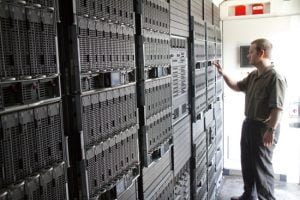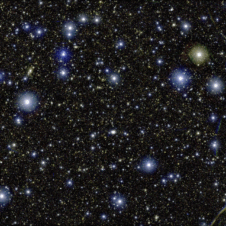
Photo of POD in-situ at iVEC@Murdoch. Image courtesy iVEC.
For the first time in history, Western Australia has entered the prestigious ranks of the top 100 supercomputers on the planet, thanks to iVEC’s installation of a Performance Optimised Data Centre (POD) at its Murdoch facility.
A global gauge of the world’s most powerful supercomputers, the prestigious Top 500 List has embraced the Hewlett- Packard (HP)-developed POD, which takes its place at #87 following its delivery to iVEC@Murdoch.
Only one other Australian supercomputer ranks above the POD in the Top 500 list, with the National Computational Infrastructure facility in Canberra coming in at #51.
The POD is Stage 1A of the $80M Pawsey Centre project, commissioned under the Commonwealth government’s $1.1 billion Super Science Initiative to establish a petascale supercomputing facility.
The construction of the following stages, to be housed at various iVEC facilities in coming years, will eventually see the Pawsey Centre climb to the top echelon of the world’s supercomputing centres and establish Australia’s commitment to supercomputing. When complete in early 2013, the final Pawsey Centre is expected to operate up to 15 times faster than the POD.
“Australia is looking to build three petascale systems in the next few years, which is an extraordinary leap,” iVEC Executive Director Andrew Rohl said.
“Enabling our users to access advanced resources in the 100 TeraFLOPS range, through the HP POD system, will provide them the opportunity to grow into the petascale era.”
Incorporating modified shipping container architecture, the POD design allows rapid setup compared to similar-sized systems, creating a ‘plug and play’ compute cluster requiring simple connection to networking and power.
The cluster is an energy-efficient 87.20 TeraFLOPS system (1 TeraFLOPS = one trillion floating point operations per second), using HP ProLiant Blade servers with 1600 of the latest generation Intel® Xeon® 5600 processors, totalling 9,600 cores and with 500 terabytes of high-performance storage all connected via 4x infiniband.
Housed at Murdoch University, the cluster will be connected to iVEC’s Metropolitan Area Network, which operates at 10 gigabits per second. iVEC@Murdoch Associate Director, Professor Matthew Bellgard, said the ranking in the world’s top 100 supercomputers confirmed the extraordinary increase in locally-available computational capacity.
“Australian scientists are now generating massive amounts of experimental data in computationally demanding areas such as radioastronomy, nanoscience, geoscience and life science.
“The facility represents a major advancement in computational research in Australia where scientific discovery is largely dependent on the ability to process masses of information as quickly as possible.“What has been recognised by the ranking is the fact that the supercomputer will enable processing of data at speeds which we have not previously encountered.”
Professor Bellgard said the approach to housing the HP supercomputer in a self-contained energy efficient POD, was just one of the many innovations that the supercomputer possessed.
ICRAR and iVEC are working together to provide high performance computing capability to radio astronomy in Australia and promote Australia and New Zealand’s bid to host the Square Kilometre Array.

